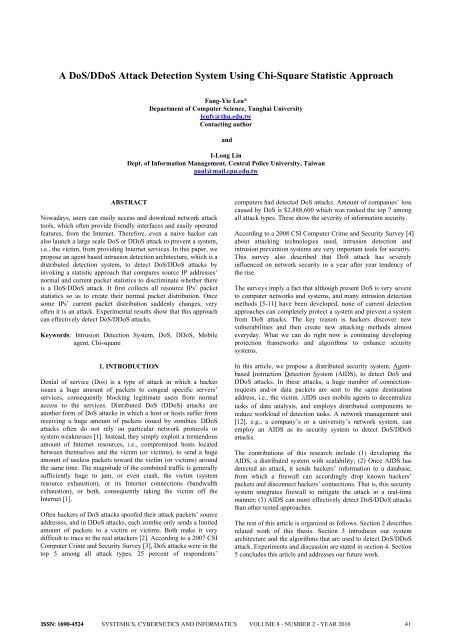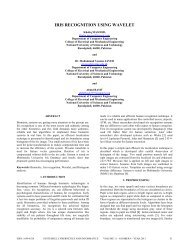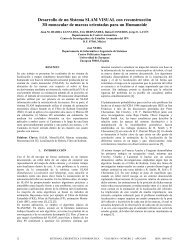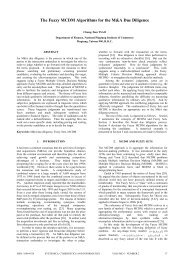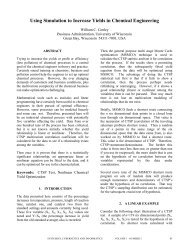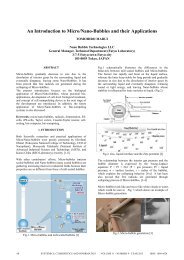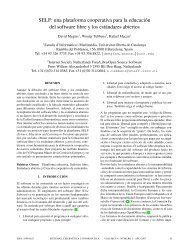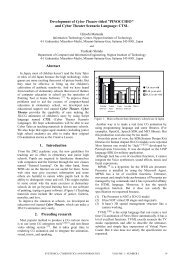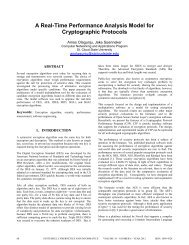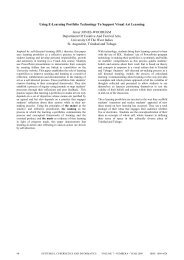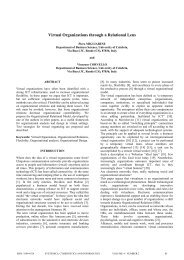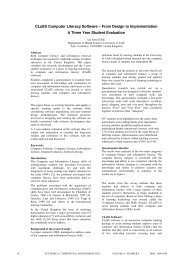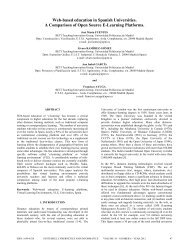A DoS/DDoS Attack Detection System Using Chi-Square Statistic ...
A DoS/DDoS Attack Detection System Using Chi-Square Statistic ...
A DoS/DDoS Attack Detection System Using Chi-Square Statistic ...
Create successful ePaper yourself
Turn your PDF publications into a flip-book with our unique Google optimized e-Paper software.
A <strong>DoS</strong>/D<strong>DoS</strong> <strong>Attack</strong> <strong>Detection</strong> <strong>System</strong> <strong>Using</strong> <strong>Chi</strong>-<strong>Square</strong> <strong>Statistic</strong> Approach<br />
Fang-Yie Leu*<br />
Department of Computer Science, Tunghai University<br />
leufy@thu.edu.tw<br />
Contacting author<br />
and<br />
I-Long Lin<br />
Dept. of Information Management, Central Police University, Taiwan<br />
paul@mail.cpu.edu.tw<br />
ABSTRACT<br />
Nowadays, users can easily access and download network attack<br />
tools, which often provide friendly interfaces and easily operated<br />
features, from the Internet. Therefore, even a naive hacker can<br />
also launch a large scale <strong>DoS</strong> or D<strong>DoS</strong> attack to prevent a system,<br />
i.e., the victim, from providing Internet services. In this paper, we<br />
propose an agent based intrusion detection architecture, which is a<br />
distributed detection system, to detect <strong>DoS</strong>/D<strong>DoS</strong> attacks by<br />
invoking a statistic approach that compares source IP addresses’<br />
normal and current packet statistics to discriminate whether there<br />
is a <strong>DoS</strong>/D<strong>DoS</strong> attack. It first collects all resource IPs’ packet<br />
statistics so as to create their normal packet distribution. Once<br />
some IPs’ current packet distribution suddenly changes, very<br />
often it is an attack. Experimental results show that this approach<br />
can effectively detect <strong>DoS</strong>/D<strong>DoS</strong> attacks.<br />
Keywords: Intrusion <strong>Detection</strong> <strong>System</strong>, <strong>DoS</strong>, D<strong>DoS</strong>, Mobile<br />
agent, <strong>Chi</strong>-square<br />
1. INTRODUCTION<br />
Denial of service (Dos) is a type of attack in which a hacker<br />
issues a huge amount of packets to congeal specific servers’<br />
services, consequently blocking legitimate users from normal<br />
access to the services. Distributed <strong>DoS</strong> (D<strong>DoS</strong>) attacks are<br />
another form of <strong>DoS</strong> attacks in which a host or hosts suffer from<br />
receiving a huge amount of packets issued by zombies. D<strong>DoS</strong><br />
attacks often do not rely on particular network protocols or<br />
system weaknesses [1]. Instead, they simply exploit a tremendous<br />
amount of Internet resources, i.e., compromised hosts located<br />
between themselves and the victim (or victims), to send a huge<br />
amount of useless packets toward the victim (or victims) around<br />
the same time. The magnitude of the combined traffic is generally<br />
sufficiently huge to jam, or even crash, the victim (system<br />
resource exhaustion), or its Internet connections (bandwidth<br />
exhaustion), or both, consequently taking the victim off the<br />
Internet [1].<br />
Often hackers of <strong>DoS</strong> attacks spoofed their attack packets’ source<br />
addresses, and in D<strong>DoS</strong> attacks, each zombie only sends a limited<br />
amount of packets to a victim or victims. Both make it very<br />
difficult to trace to the real attackers [2]. According to a 2007 CSI<br />
Computer Crime and Security Survey [3], <strong>DoS</strong> attacks were in the<br />
top 5 among all attack types. 25 percent of respondents’<br />
computers had detected <strong>DoS</strong> attacks. Amount of companies’ loss<br />
caused by <strong>DoS</strong> is $2,888,600 which was ranked the top 7 among<br />
all attack types. These show the severity of information security.<br />
According to a 2008 CSI Computer Crime and Security Survey [4]<br />
about attacking technologies used, intrusion detection and<br />
intrusion prevention systems are very important tools for security.<br />
This survey also described that <strong>DoS</strong> attack has severely<br />
influenced on network security in a year after year tendency of<br />
the rise.<br />
The surveys imply a fact that although present <strong>DoS</strong> is very severe<br />
to computer networks and systems, and many intrusion detection<br />
methods [5-11] have been developed, none of current detection<br />
approaches can completely protect a system and prevent a system<br />
from <strong>DoS</strong> attacks. The key reason is hackers discover new<br />
vulnerabilities and then create new attacking methods almost<br />
everyday. What we can do right now is continuing developing<br />
protection frameworks and algorithms to enhance security<br />
systems.<br />
In this article, we propose a distributed security system, Agentbased<br />
Instruction <strong>Detection</strong> <strong>System</strong> (AIDS), to detect <strong>DoS</strong> and<br />
D<strong>DoS</strong> attacks. In these attacks, a huge number of connectionrequests<br />
and/or data packets are sent to the same destination<br />
address, i.e., the victim. AIDS uses mobile agents to decentralize<br />
tasks of data analysis, and employs distributed components to<br />
reduce workload of detection tasks. A network management unit<br />
[12], e.g., a company’s or a university’s network system, can<br />
employ an AIDS as its security system to detect <strong>DoS</strong>/D<strong>DoS</strong><br />
attacks.<br />
The contributions of this research include (1) developing the<br />
AIDS, a distributed system with scalability; (2) Once AIDS has<br />
detected an attack, it sends hackers’ information to a database,<br />
from which a firewall can accordingly drop known hackers’<br />
packets and disconnect hackers’ connections. That is, this security<br />
system integrates firewall to mitigate the attack in a real-time<br />
manner; (3) AIDS can more effectively detect <strong>DoS</strong>/D<strong>DoS</strong> attacks<br />
than other tested approaches.<br />
The rest of this article is organized as follows. Section 2 describes<br />
related work of this thesis. Section 3 introduces our system<br />
architecture and the algorithms that are used to detect <strong>DoS</strong>/D<strong>DoS</strong><br />
attack. Experiments and discussion are stated in section 4. Section<br />
5 concludes this article and addresses our future work.<br />
ISSN: 1690-4524<br />
SYSTEMICS, CYBERNETICS AND INFORMATICS VOLUME 8 - NUMBER 2 - YEAR 2010 41
2. BACKGROUND AND RELATED WORK<br />
Feinstein et al. [13] used chi-square formula to detect <strong>DoS</strong> attacks.<br />
The authors classify network connections into six groups, called<br />
previous groups, according to packets’ receiving frequencies, and<br />
calculate the total frequency of normal connections for each<br />
group. When detecting attacks, the detector again classifies<br />
frequencies of current connections, and classify then into six<br />
groups, called current groups. It then compares the frequency of<br />
previous group i and that of current group i with chi-square<br />
statistic method to see whether or not the difference is significant.<br />
If so, we can suspect that there is a <strong>DoS</strong> or D<strong>DoS</strong> attack.<br />
However, several problems exist in this system. The first is that<br />
there are only six groups. For a huge institute or organization, the<br />
number should be increased. Otherwise, too many IPs are in a<br />
group, resulting higher false positives. The second, there is no<br />
way to identify who the backers are once a <strong>DoS</strong>/D<strong>DoS</strong> is<br />
discovered. To solve this problem, we create a mechanism to do<br />
this. The third, if hackers issue a <strong>DoS</strong>/D<strong>DoS</strong> attack with a specific<br />
protocol, e.g., icmp flooding, due to only occupying a portion of<br />
total packets, the attack is hard to be detected. The fourth is<br />
before calculating chi-square statistics, the authors grouped IPs<br />
based on their current connection frequencies rather than<br />
following the classification of previous groups. That is, a packet<br />
which is classified into previous group i may be classified into<br />
current group j,1 ≤i, j ≤6,<br />
i≠ j, again resulting in the fact that we<br />
only know that there is a <strong>DoS</strong>/D<strong>DoS</strong> attack, but do not know who<br />
is issuing the attack. The final problem is the authors failed to<br />
considered network consumption attacks. They only considered<br />
resource consumption attack. In fact, network consumption attack<br />
can be detected by the same method.<br />
2.1 Scenario of Distributed <strong>DoS</strong> attack<br />
A D<strong>DoS</strong> attack often has two issuing stages to set up an attack,<br />
including control stage and attack stage. In control stage, the<br />
hacker looks for vulnerable systems and install handlers/masters<br />
and zombies/daemons by exploring system vulnerabilities.<br />
Famous D<strong>DoS</strong> master and agent programs include Trinoo, Tribe<br />
Flood Network 2000, and Stacheldraht.<br />
In a D<strong>DoS</strong> attack, the handlers are the first level vulnerable hosts<br />
controlled by the attacker. The zombies are the second level<br />
vulnerable hosts controlled by the attacker through the handlers.<br />
Most of the control messages in control stage are single direction<br />
from attacker and handler, but is bi-direction between handlers<br />
and zombies. After the control stage, the list of vulnerable hosts is<br />
then entering their attack stage and launching a D<strong>DoS</strong> attack.<br />
2.2 Mobile agents<br />
A mobile agent is a program which has the ability to migrate<br />
among heterogeneous network systems. It can autonomously<br />
determine when to transfer to another system and where it can or<br />
should move to. An IDS that deploys mobile agents to detect<br />
attacks has advantages over a traditional IDS in that [14,15] it can<br />
(1) Reduce network load: Mobile agents can execute programs<br />
stored in servers where they current reside to avoid issuing many<br />
requests and transferring a huge amount of data to and from other<br />
servers. This can reduce network burden and speed up data<br />
processing.<br />
(2) Overcome network latency: Real-time systems do not permit<br />
long network latency. A mobile agent can monitor and control an<br />
underlying environment and respond appropriately and<br />
immediately.<br />
(3) Encapsulate protocols: In a distribution system, although<br />
information is exchanged by using specific communication<br />
protocols, two heterogeneous systems with different<br />
communication protocols are hard to communicate with each<br />
other. However, a mobile agent can encapsulate packets of other<br />
protocols into a new packet as the new packet’s payload, and send<br />
the new packet to next node. This is known as tunneling.<br />
Information can be then exchanged.<br />
(4) Execute independently and autonomously: Mobile agents can<br />
autonomously perform tasks that users assign to them. They can<br />
also autonomously and independently determine when to migrate<br />
to other nodes and where to migrate.<br />
(5) Adapt dynamically: A mobile agent can adjust its running<br />
method according to the change of its operational environment.<br />
(6) Naturally heterogeneous: A network may consist of many<br />
heterogeneous nodes which are connected by network links, and<br />
which provide different operating systems and applications<br />
running on different hardware platforms. A mobile agent can<br />
adapt itself in such a heterogeneous environment. Also, when a<br />
host is going to be shut down, all mobile agents now residing on<br />
the host will be notified to migrate to other nodes so as to<br />
continue their operations and tasks.<br />
2.3 Related Work<br />
D-WARD [16] is a source-end D<strong>DoS</strong> defense system, which can<br />
identify malicious flows at the source end due to its architecture<br />
near to attack’s source more effectively to discover attack, but it<br />
more difficult to deployment and detection. And its architecture<br />
contains statistics normal traffic models on three types including<br />
TCP, UDP and ICMP. Once an attack is discovered, it would<br />
control traffic, but D-WARD only deny by a rate limit. Actually,<br />
it will still impact on the performance of Internet. However,<br />
attackers can still successfully perform those attacks from<br />
unprotected network. In addition, those system require spending a<br />
huge amount money and time to deployed.<br />
DefCOM [17] is a distributed framework for D<strong>DoS</strong> defense. It<br />
consists of heterogeneous defense nodes organized in a peer-topeer<br />
network, communicating to achieve a dynamic cooperative<br />
defense and it carried out victim end, source end, and network<br />
core defenses mechanisms to perform attack detection, traffic<br />
differentiation and rate-limiting, respectively. Its components are<br />
of different types and can fulfill, e.g., only filtering or only attack<br />
detection. There are three types of nodes including alert generator<br />
to detect the attack and inform other nodes, classifier to<br />
distinguish legitimate traffic and rate-limiter. When under a<br />
D<strong>DoS</strong> attack, all nodes communicate with each other by flooding<br />
messages, however, this approach is only effective with all core<br />
router deployed at least. In addition, the compromised overlay<br />
nodes can do harm to the DefCOM operation. Another D<strong>DoS</strong><br />
defense [18] allows implementing the cooperation of two and<br />
more perimeter defense systems.<br />
The Distributed Intrusion <strong>Detection</strong> <strong>System</strong> (DIDS) [19] project<br />
was sponsored by the United States Air Force Cryptologic<br />
Support Center through a contract with the Lawrence Livermore<br />
National Labs. The DIDS architecture combines distributed<br />
monitoring and data reduction with centralized data analysis, but<br />
it did not scale well for large networks since addition of any new<br />
component increases the load on the DIDS director component,<br />
and the data flow from monitors to DIDS director consumes high<br />
42 SYSTEMICS, CYBERNETICS AND INFORMATICS VOLUME 8 - NUMBER 2 - YEAR 2010 ISSN: 1690-4524
network bandwidth. Our proposed approach focuses on scalability<br />
problems by using mobile agents to decentralize task of data<br />
analysis, and employs distributed components to reduce workload<br />
of detection tasks.<br />
The Autonomous Agents for Intrusion <strong>Detection</strong> (AAFID) [20]<br />
made use of multiple layers of agents organized in a hierarchical<br />
structure with each layer performing a set of intrusion detection<br />
tasks. Administrator can send global instructions to all agents so<br />
that network and data can be respectively monitored and analyzed<br />
on each node. Data on end nodes are collected by agents which<br />
are dispatched by local monitoring nodes. Local monitoring nodes<br />
are responsible for analyzing data gathered by agents. Global<br />
monitoring nodes are in charge of integrity monitoring. However,<br />
AAFID uses only static agents and is deprived of some of the<br />
benefits mobile agents can offer.<br />
The Lightweight agents for intrusion detection [21] had been<br />
developed for an IDS that deploys distributed multiple layers of<br />
lightweight intelligent mobile agents and applies data mining<br />
techniques to detect intrusions. An agent monitor system roams<br />
around different system networks, analyzing and integrating<br />
collected information and transferring the results to users and at<br />
last, storing the results into a database. This system allows an<br />
agent to increase its new ability during its execution period, and<br />
provides more convenient mechanisms to improve IDS’s<br />
communication capability.<br />
3. SYSTEM ARCHITECTURE<br />
AIDS system architecture as shown in Figure 1 consists of five<br />
main components, including event monitoring subsystems,<br />
backup subsystems, mobile agents, a duty center and a black list<br />
database.<br />
An event monitoring subsystem is employed to protect<br />
geographically concentrated subnets which are subnets<br />
geographically located together or nearby. A building with<br />
several subnets owned by different departments or the same<br />
department is an example. This subsystem monitors source and<br />
destination addresses of packets to detect whether there is a<br />
<strong>DoS</strong>/D<strong>DoS</strong> attacks. Once detected, it dispatches a mobile agent to<br />
send attacker’s IP address to the black list database which is a<br />
database used to record hackers’ information and intrusion details.<br />
In addition, it periodically dispatches another mobile agent to<br />
send the packet statistics to the duty center, which is the<br />
coordinator of an AIDS installed in a specific location, e.g., the<br />
computer center of a university, for further detecting whether or<br />
not there is a D<strong>DoS</strong> attack. If a D<strong>DoS</strong> truly exits, the duty center<br />
dispatches a mobile agent to record attackers’ information also in<br />
the black list database. With the database, a firewall can<br />
accordingly filter out packets issued by known hackers.<br />
When a host is under a <strong>DoS</strong>/D<strong>DoS</strong> attack and loses its detection<br />
capability, a node will be chosen from the corresponding backup<br />
subsystem and requested to substitute for the attacked one.<br />
Figure 1. AIDS system architecture<br />
ISSN: 1690-4524<br />
SYSTEMICS, CYBERNETICS AND INFORMATICS VOLUME 8 - NUMBER 2 - YEAR 2010 43
Port<br />
#<br />
Group<br />
#<br />
Past<br />
7 th -<br />
day<br />
count<br />
Past<br />
6 th -<br />
day<br />
count<br />
Past<br />
5 th -<br />
day<br />
count<br />
Table 1. A source-IP distribution table (IP-based)<br />
Past<br />
4 th -<br />
day<br />
count<br />
Past<br />
3 rd -<br />
day<br />
count<br />
Packet-information<br />
Past<br />
2 nd -<br />
day<br />
count<br />
Past<br />
1 st -<br />
day<br />
count<br />
One-week<br />
count= ∑<br />
7<br />
i= 1<br />
i th day count<br />
Source-IPaddr<br />
Currentday<br />
count<br />
Past-10-<br />
sec<br />
count<br />
G% N%<br />
10-secbase<br />
<strong>Chi</strong>square<br />
%<br />
<strong>Chi</strong>square<br />
for<br />
amount<br />
Group#<br />
Past-<br />
7 th -day-size<br />
…<br />
Table 2. A source-IP distribution table (group-based)<br />
Packet-information<br />
One-week<br />
10-secbase<br />
size= 7 Current daysize<br />
G% N%<br />
∑ ith -day size<br />
Past-10-secsize<br />
i= 1<br />
<strong>Chi</strong>square<br />
<strong>Chi</strong>-square<br />
for amount<br />
%<br />
Event Monitoring Subsystem<br />
An event monitoring subsystem as shown in Figure 1 consists of<br />
event analyzers and an event collector. An event analyzer is<br />
employed to detect <strong>DoS</strong>/D<strong>DoS</strong> attacks launched to the subnets<br />
that it protects. An event collector collects event information and<br />
packet statistics from its subordinate event analyzers, detects<br />
whether there is an <strong>DoS</strong>/D<strong>DoS</strong> attack and reports attacking<br />
information to the black list database.<br />
An Event Analyzer: An event analyzer collects packets<br />
sent to hosts that it protects through a switch having a mirror port.<br />
A packet flowing through the switch will be duplicated and sent<br />
out via the mirror port from which an event analyzer gathers all<br />
its detection packets. The original packet will continue its journey<br />
to its destination. In addition, an event analyzer collects source<br />
and destination addresses of packets sent to protected subnets, and<br />
counts number of packets that each sender (source IP address)<br />
sends to a specific host or subnet in the protected subnets in order<br />
to produce a source-IP distribution table (which will be described<br />
later) from which the event analyzer can detect <strong>DoS</strong>/D<strong>DoS</strong><br />
attacks, and identify who is issuing the attacks. An event analyzer<br />
periodically once per ten second dispatches a mobile agent, called<br />
delivery agent, to deliver the source-IP distribution table to its<br />
coordinating event collector. An event collector on receiving the<br />
table accumulates the table contents to it source-IP accumulation<br />
table which is a table used to accumulate packet statistics for the<br />
subnets in the underlying geographically concentrated unit.<br />
(1) Source-IP distribution table: A source-IP distribution table<br />
as shown in Table 1 is an IP-based table. Each source IP has its<br />
own tuple to record the IP’s packet information. This table<br />
consists of Source-IP, port#, group#, packet-information, 10-secbase,<br />
group-percentage (G%), N-percentage (N%), chi-squarepercentage,<br />
and chi-square for amount where Source-IP records<br />
source IP of a received packet, e.g., packet P, port# lists the ports<br />
that has been used by P’s sender, group# identifies which group P<br />
belongs to. Details of groups will be described later. Packetinformation<br />
consists of two portions, packet-information-amount<br />
and packet-information-size. The former (the later) is used to<br />
count number of packets (to accumulate size of packets) that P’s<br />
sender has sent during a specific period of time. Packetinformation-amount<br />
has 10 subfields, including past 7 days’<br />
counts, (i.e., past-i th -day-count, i=1,2,…7), one-week-count,<br />
current-day-count and past-10-sec-count. Past-i th -day-count<br />
records the past i th day’s packet count, one-week-count=<br />
7<br />
∑ past-ith -day-count, current-day-count records packet counts<br />
i=1<br />
for current day, and past-10-sec-count keeps information of past<br />
10 seconds. Packet-information-size has also 10 subfields where<br />
field names are exactly the same as those of packet-informationcount,<br />
except the “count” in each field name is substituted by<br />
“size” since these subfields are used to accumulate sizes of<br />
receiving packets rather than counts of the receiving packets. For<br />
7<br />
example, one-week-size== ∑ past-ith -day-size which<br />
i=1<br />
accumulates sizes of receiving packets for the past 7 days.<br />
However, to avoid redundantly listing them, Table 1 only lists<br />
packet-information-count portion. 10-sec-base records the 10 sec<br />
average of an IP’s normal traffic in the past one week. Grouppercentage<br />
represents the percentage of packet counts that a group<br />
received previously under normal circumstance over the total<br />
number of packets that the system has received, N-percentage is<br />
defined as the number of packets that a group has currently<br />
received, e.g., Qi, over total number of packets the network has<br />
received, i.e., Q, in the past 10 seconds (i.e., N-<br />
percentage= Qi<br />
/ Q ), chi-square-percentage defined as<br />
2<br />
( N% − G%) / G%<br />
is used to analyze whether or not there is a<br />
resource consumption attack, chi-square for amount defined as<br />
2<br />
(( past −10 −sec −size) −(10 −sec −base))<br />
is employed to<br />
10 −sec−base<br />
analyze whether or not there is a bandwidth consumption attack.<br />
However, in the following, we remove field name of packetinformation<br />
to make all its subfields to be level-one fields.<br />
Further, to clearly illustrate behaviors of a group instead of<br />
individual behaviors of single IPs, we create another table, called<br />
group-IP distribution table, which calculates values for different<br />
group features. The values are obtained by summing up field<br />
values recorded in the corresponding source-IP distribution table.<br />
The group-IP distribution table, as shown in Table 2, has the same<br />
attributes as those of Table 1. But omitting Sorrce-IP-address and<br />
port# since in a group-based table, the two fields lose their<br />
original features.<br />
From the group-IP distribution table, we can realize which group<br />
or groups, e.g., groups1’, 2’,…k’, k’≦13, are issuing <strong>DoS</strong>/D<strong>DoS</strong><br />
attacks. Therefore, the search space of finding out who are<br />
launching the attacks can be reduced to the IPs that belong to<br />
groups 1’, 2’, …k’. Now, we can realize who is issuing the attack<br />
by checking packet-information-amount and packet-informationsize<br />
subfields and source-IP field in their original source-IP<br />
distribution table. The source-IP can be used to trace back to the<br />
hacker. In addition, we can close the ports that P’s sender has<br />
used once the sender is suspected as a hacker.<br />
(2) Baseline Profile Establishment: Before detection, we first<br />
collect ordinary packets for subunits of a geographically<br />
44 SYSTEMICS, CYBERNETICS AND INFORMATICS VOLUME 8 - NUMBER 2 - YEAR 2010 ISSN: 1690-4524
concentrated unit for one week, filter out attack packets and<br />
calculate their normal packet counts and normal accumulated<br />
packet sizes. The IP with the largest amount of packets is ranked<br />
number one. The second largest amount is ranked number two,<br />
and so on. After that, we classify them into 13 groups as follows.<br />
That ranked number one constitutes the first group, i.e., group 0.<br />
Those ranked number two and three are group 1. The<br />
classification is shown in Figure 2.<br />
The baseline profile is updated every 24 hours. Each time after<br />
update, we recalculate chi-square value x i<br />
for each group i,<br />
i=0,1,2,……12, as their new baseline profile values,<br />
where xk ≥ x j when k>j, k=0,1,2,…………11, and<br />
j=1,2,3,……12.<br />
Group#<br />
Range of<br />
source IPs<br />
Ranked no.<br />
Group 0 2 0 1<br />
Group 1 2 1 ~2 2 -1 2,3<br />
Group 2 2 2 ~2 3 -1 4,5,6,7<br />
Group 3 2 3 ~2 4 -1 8,9,10,11,12,13,14,15<br />
Group 4 2 4 ~2 5 -1 16,17,18,……………31<br />
Group 5 2 5 ~2 6 -1 32,33,34,……………63<br />
Group 6 2 6 ~2 7 -1 64,65,66,……………127<br />
Group 7 2 7 ~2 8 -1 128,129,130,………..255<br />
Group 8 2 8 ~2 9 -1 256,257,258,………..511<br />
Group 9 2 9 ~2 10 -1 512,513,514,……….1023<br />
Group 10 2 10 ~2 11 -1 1024,1025,1026,…...2047<br />
Group 11 2 11 ~2 12 -1 2048,2049,…………4095<br />
Group 12 2 12 and up 4096 and remaining<br />
Figure 2 classification of collected source IPs<br />
(3) Algorithms: Algorithms for establishing a source-IP<br />
distribution table and Baseline Profile are as follows:<br />
Algorithm 1: Establishing a source-IP distribution table T D-IP<br />
Input: An incoming packet P with source IP S-IP and destination<br />
IP D-IP;<br />
Output: update S-IP’s information in T D-IP , or insert a new tuple<br />
with source IP address=S-IP into T D-IP<br />
{1. If (S-IP is already in T D-IP , e.g., tuple t) { /* i.e., t.source-IP =<br />
S-IP */<br />
1.1 t.past-10-sec-count ++;<br />
1.2 t.past-10sec-size =t.past-10sec-size + P ; /*|P|: packet<br />
size*/<br />
1.3 If (P’s port# is not in “port#” field) Append the port# to<br />
“port#” field; /* accumulating port # */}<br />
Else { /* S-IP is absent from T D-IP */<br />
1.4 Retrieve port # from P; , e.g., port j;<br />
1.5 Insert(source-IP=S-IP, port #=port j, past-10-sec-count=1,<br />
past-10sec-size= P ;) into T D-IP ; /* insert a new tuple, and<br />
other fields are given null values*/ }<br />
2. If (timer times out) {<br />
/*accumulate current-day-count/size, reset past-10-sec<br />
count/size and detect <strong>DoS</strong>/D<strong>DoS</strong> per 10 seconds*/<br />
2.1 t.current-day-count=t.current-day-count + t.past-10-seccount;<br />
2.3 t.current-day-size=t.current-day- size + t.past-10-sec-size;<br />
2.4 t.past-10-sec-count=0;<br />
2.5 t.past-10-sec-size=0;<br />
2.6 Call Algorithm 3; /*detecting <strong>DoS</strong>/D<strong>DoS</strong> attack per 10<br />
seconds*/<br />
2.7 Set timer to 10 seconds;}<br />
The algorithm that establishes a baseline profile is as follows.<br />
Algorithm 2: Establishing a baseline profile /* summing up the<br />
past 7-day’s counts/sizes and classifying source IPs<br />
in a source-IP distribution table into 13 groups */<br />
Input: a source-IP distribution table T which contains two tables,<br />
T-count and T-size<br />
Output: tuples in T are classified into 13 groups<br />
{If (timer times out) /* timer’s initial value=24 hr */<br />
1.1 For ( i=6; i
n−1<br />
n−1<br />
2 Ni−count<br />
− Gi −count<br />
x<br />
count<br />
= , and 2 Ni−count<br />
− Gi −count<br />
∑ x<br />
count<br />
= ∑<br />
i= 0 Gi −count<br />
i= 0 Gi −count<br />
where Ni−count<br />
( Ni−size)<br />
is number of packets (accumulated<br />
packet size) that group i has currently received in past 10 seconds,<br />
i=0,1,2,…12, n=13, and degree of freedom is df=12 (=n -1).<br />
In this research, we choose significant standard α = 0.05 and<br />
2<br />
x12, α<br />
= 21.026 . If x 2 ≤ x 2 , we accept the null hypothesis H ,<br />
12, α<br />
0<br />
indicating that there is no attack where x 2 may be either x 2 count or<br />
x 2 size. However, if 2 2 2 2<br />
x<br />
count<br />
> x (or<br />
12, α<br />
x<br />
size<br />
> x ) , we reject<br />
12, α<br />
H , which means its alternative hypothesis<br />
0<br />
H is true, showing<br />
1<br />
that there is a suspected resource consumption (bandwidth<br />
consumption) attack.<br />
Algorithm 3: detecting <strong>DoS</strong> attack by using chi-square statistic<br />
method invoked by an event analyzer for every ten<br />
seconds.<br />
Input: a source-IP distribution table T; baseline profile-count;<br />
baseline profile-size<br />
Output: whether or not a subnet or subnets protected by an event<br />
analyzer are under a <strong>DoS</strong>/D<strong>DoS</strong> attack<br />
{1. Att=false;<br />
2. If ( x 2 ( 2 count<br />
≥ x<br />
12, α<br />
+ threshold))<br />
/* a resource consumption<br />
attack is discovered */<br />
{For (i=0; i threshold )<br />
i−count<br />
Gi −count<br />
Choose k IPs whose past-10-sec-counts are the highest as<br />
the suspected hackers, where<br />
j= k−1<br />
m i −1<br />
∑ past −10 −sec −count / ∑ past −10 −sec−count<br />
j in<br />
j<br />
j= 0 j=<br />
0<br />
≥ 80%<br />
which m i is number of source IPs in group i;<br />
Send attack information to the black list database, and an<br />
alter message to administrator to show that there is a<br />
resource consumption <strong>DoS</strong>/D<strong>DoS</strong> attack;}<br />
3. If ( x 2 ( 2 size<br />
≥ x<br />
12, α<br />
+ threshold))<br />
/* a bandwidth consumption<br />
attack is discovered */<br />
{For (i=0; i threshold<br />
)<br />
i−size<br />
Gi−<br />
size<br />
Choose k IPs whose past-10-sec-sizes are the highest as<br />
the suspected hackers, where<br />
j= k−1<br />
m i −1<br />
∑ past−10 −sec −size / ∑ past−10 −sec−sizej<br />
;<br />
j<br />
j= 0 j=<br />
0<br />
≥ 80%<br />
Send attack information to the black list database, and an<br />
alter message to administrator to show that there is a<br />
resource consumption <strong>DoS</strong>/D<strong>DoS</strong> attack;}}<br />
An Event Collector<br />
As stated above, an event analyzer periodically, once per 10<br />
seconds, sends its source-IP distribution table to its event<br />
collector which on receiving the table, for each source IP address<br />
retrieves the corresponding count and size from the table, sums up<br />
the counts and sizes for each packet information subfield (a total<br />
of 10+10 subfields) and records the results in the corresponding<br />
subfields in its own source-IP accumulation table, which has the<br />
same schema as that of Table 1. In other words, the values of<br />
packet information subfields of a source IP address P appearing in<br />
different source-IP distribution tables will be summed up as total<br />
counts/sizes of the corresponding subfields of P in a source-IP<br />
accumulation table. For example, in the source-IP accumulation<br />
table, P’s past-i th -day-count is the sum of P’s past-i th -day-counts<br />
in all the received source-IP distribution tables,1≤i<br />
≤ 7.<br />
An event collector should receive source-IP distribution tables<br />
periodically from all its event analyzers. When it does not receive<br />
the table from an event analyzer, it dispatches a mobile agent as a<br />
backup agent to check status of the event analyzer. If the event<br />
analyzer is still alive, the backup agent asks the event analyzer to<br />
send the source-IP distribution table to the event collector.<br />
Otherwise, the backup agent will request the corresponding<br />
backup subsystem to select a host to take over for the failed event<br />
analyzer. The functions of the backup host are exactly the same as<br />
those of an event analyzer.<br />
An event collector detects whether a geographically concentrated<br />
unit is attacked by a <strong>DoS</strong>/D<strong>DoS</strong> or not also based on chi-square<br />
statistic approach. It calculates chi-square values of normal<br />
network traffic in advance for a geographically concentrated unit<br />
by using the algorithm similar to Algorithm 3 with the given<br />
source-IP distribution table substituted by its source-IP<br />
accumulation table. Its baseline profile values are also generated<br />
from the accumulation table beforehand. Each time, when an<br />
event collector finishes collecting source-IP distribution tables<br />
and updating its own source-IP accumulation table, of course<br />
once per 24 hours, it periodically once per 10 seconds checks to<br />
see whether the chi-square value of current network traffic for its<br />
13 groups significantly exceeds its threshold or not. If yes, it<br />
dispatches a mobile agent as a update agent to send hacker<br />
information to the black list database. And regardless of yes or<br />
not, it dispatches a mobile agent as a notifying agent to send its<br />
source-IP accumulation table, also per 10 seconds, to the duty<br />
center, which will integrate contents of source-IP accumulation<br />
tables delivered by all event collectors, into its source-IP<br />
integration table from which the duty center can further detect<br />
D<strong>DoS</strong> attacks, particularly for low-density <strong>DoS</strong>/D<strong>DoS</strong> attacks,<br />
which are hard to be detected by an event collector.<br />
Duty Center<br />
The duty center, as the coordinator of AIDS, further detects<br />
whether or not there is a <strong>DoS</strong>/D<strong>DoS</strong> attack which is attacking the<br />
protected system. The duty center builds a source-IP integration<br />
table, of which the table structure is similar to that of a source-IP<br />
distribution table, to detect attacks. If yes, the duty center<br />
dispatches a mobile agent to record attackers’ information also in<br />
the black list database. With the database, a firewall can<br />
accordingly filter out packets issued by known hackers.<br />
Algorithm 4 shows the detection details of the duty center.<br />
Algorithm 4: process of the duty center<br />
Input: source-IP accumulation tables received periodically<br />
Output: whether network management unit, e.g., a<br />
university/company, is under a D<strong>DoS</strong> attack<br />
{1. If (timer generated for an event collector times out)<br />
{Dispatches a mobile agent as a backup agent to check status<br />
of event collector;<br />
If (event collector fails)<br />
Send a message to the corresponding backup subsystem<br />
to choose a host to take over for the failed event collector;<br />
46 SYSTEMICS, CYBERNETICS AND INFORMATICS VOLUME 8 - NUMBER 2 - YEAR 2010 ISSN: 1690-4524
Else asks the event collector to send content of its source-<br />
IP accumulation table to the duty center;}<br />
2. Integrate all source-IP accumulation tables received to<br />
generate its source-IP integration table;<br />
3. Detect whether there is a <strong>DoS</strong>/D<strong>DoS</strong> attack by calculating G i-<br />
count, G i-siez , x 2 count and x 2 size at duty-center level;<br />
4. If (yes)<br />
{Send a message to administrators;<br />
Dispatch an update agent to deliver hacking information to<br />
the black list database;}}<br />
Backup Subsystem<br />
When an event analyzer (an event collector) is under a<br />
Dos/DDos attack and loses its detection capability, as stated<br />
above, its event collector (the duty center) dispatches a backup<br />
agent to the corresponding backup subsystem, asking the<br />
subsystem to choose a host to substitute for the attacked event<br />
analyzer (an event collector). The process of selecting a backup<br />
host by an event collector is as follows.<br />
Algorithm 5: process of choose a backup host for an attacked<br />
event analyzer<br />
Input: a set of hosts H= {h 1 ,h 2 ,h 3 ,…h m } in the underlying<br />
geographically concentrated unit, where m is number of hosts in<br />
the backup subsystem<br />
Output: the chosen host acts as an event analyzer<br />
{1. Choose the host with the highest performance, e.g., h i ;<br />
2. Send a message to request h i acting as an event analyzer to<br />
take over for the failed event analyzer;<br />
3. Change h i ’s network interface (i.e., network card) into<br />
promiscuous mode to filter packets sent to the protected<br />
subnet or subnets;}<br />
The algorithm that the duty center invokes to select a backup host<br />
is similar to algorithm 5.<br />
Mobile Agents<br />
There are four types of mobile agents. The first is delivery agents<br />
which are those dispatched by event analyzers to send source-IP<br />
distribution tables to their event collector. The second is notifying<br />
agents which are those dispatched by event collectors to send<br />
their source-IP accumulation tables to the duty center. The third is<br />
update agents which are dispatched by event analyzers, event<br />
collectors or the duty center to send hacker information to the<br />
black list database. The fourth is backup agents which are<br />
dispatched by event collectors (or the duty center) to check an<br />
attacked event analyzer’s (an attacked event collector’s) status<br />
and/or select a backup node to substitute for the attacked one.<br />
Black List Database<br />
Black list database keeps hackers’ information, e.g., hackers’<br />
source IP addresses, hacking date/time, victim IPs, protocols of<br />
attacking packets, etc. <strong>Using</strong> BLD has several advantages: (1)<br />
Identical attack information can be combined to form a record. (2)<br />
Intrusion warning can be significantly reduced. (3) If an event<br />
analyzer has detected an attack, we can prevent the attacker from<br />
sending attacking packets to other geographically concentrated<br />
units in advance. (4) Router or firewall can follow the black list in<br />
black list database to discard packets issued by hackers.<br />
Security of AIDS<br />
Readers may ask how AIDS protects itself from being attacked.<br />
All event analyzers, event collects and backup hosts are given<br />
private IPs. So they are not visible to hackers. The duty center is<br />
the only one that is given public IPs. Its security is implemented<br />
by using firewall and IDS.<br />
4. EXPERIMENTS AND DISCUSSIONS<br />
Our experimental environment comprises computers installed in<br />
computer classrooms of Science and Technology Building,<br />
Computer center and Engineering-college Building in Tunghai<br />
University. The configuration is shown in Figure 3, in which the<br />
only victim is located in Science and Technology Building, and<br />
number of attackers and their positions are listed in Table 3.<br />
Wireshark (version 0.99.5) software is installed on the victim to<br />
gather traffic issued by the attackers, and attack tools are used to<br />
send attack packets, which have their own features so that we can<br />
discriminate attack packets from normal ones.<br />
Figure 3. The configuration of our experimental<br />
environment<br />
Table 3. Numbers of attackers and their positions<br />
Building Comp. room No. of compu.<br />
Sci. and Tech. Room 1 20<br />
Computer Room 1 36<br />
Center Room 2 41<br />
Eng.-college Room 1 39<br />
Table 4. The Information about <strong>Attack</strong>s<br />
experiment <strong>Attack</strong> Type <strong>Attack</strong> Period ANP/sec<br />
1<br />
Resource<br />
Consumption<br />
<strong>Attack</strong><br />
10 sec 323,201<br />
2<br />
Bandwidth<br />
Consumption<br />
<strong>Attack</strong><br />
10 sec 32,404<br />
Table 5. Rations of attack packets distributed to each group in<br />
experiments 1 and 2.<br />
Group Experiment 1 (%) Experiment 2 (%)<br />
0 18.75 0<br />
1 34.38 0<br />
2 21.88 0<br />
3 25 0<br />
4 0 0<br />
5 0 0<br />
6 0 0<br />
7 0 49.52<br />
8 0 8.02<br />
9 0 13.06<br />
10 0 10.69<br />
11 0 10.69<br />
12 0 8.02<br />
100% 100%<br />
ISSN: 1690-4524<br />
SYSTEMICS, CYBERNETICS AND INFORMATICS VOLUME 8 - NUMBER 2 - YEAR 2010 47
Three experiments were performed in this study. Experiments 1 is<br />
a resource consumption attack, experiments 2 is a bandwidth<br />
consumption attack and experiment 3 evaluates detection<br />
accuracies of tested security systems.<br />
Table 4 lists the attack details where ANP/sec stands for average<br />
number of launched packets per second. Each attack is separately<br />
issued twenty times. Table 5 lists how many percentages of attack<br />
packets are delivered by each group in the first two experiments.<br />
For example, in experiment 1, 18.75% of attack packets were sent<br />
by the hosts belonging to baseline-profile group 0, and 34.38%<br />
were delivered by members of baseline profile group 1 and so on.<br />
(1) Experiments 1 and 2<br />
In experiment 1, only 85.6%(=2,766,800/(323,201*10)) of<br />
packets arrived at the victim, including legitimate packets and<br />
attack packets. Table 6 lists the contents of a source-IP<br />
accumulation table established in this experiment. Table 7 lists<br />
the source-IP accumulation table generated in experiment 2.<br />
However, in this table, tuples Qs that belong to a group are<br />
summed up to be a tuple R to simplify scope of the table, where<br />
R’s field i’s value= | Qs | ( tuple j’s field i's value), i=1,2,3…k, in<br />
1<br />
∑<br />
j=<br />
which k is number of fields that R and Qs have. We call the<br />
simplified table a concise accumulation table, from which, we can<br />
realize which groups are issuing <strong>DoS</strong>/D<strong>DoS</strong> attack.<br />
Besides, packets were also further classified according to their<br />
protocols so that we can detect <strong>DoS</strong>/D<strong>DoS</strong> attacks of a specific<br />
protocol. Tables 8, 9 and 10 respectively list the baseline profiles<br />
for icmp, tcp and udp, which are obtained by classifying Table 7’s<br />
tuples based on the tuples’ protocols. Of course, the<br />
corresponding baseline sub-profiles for the protocols are also<br />
generated from the original baseline profile beforehand. So, when<br />
we are interested in detecting a specific type of <strong>DoS</strong>/D<strong>DoS</strong>, e.g.,<br />
ICMP flooding, only ICMP packets are compared with ICMP<br />
baseline profile.<br />
Table 6 Packet statistics collected in experiment 1 for an event collector’s source-IP accumulation table and the chi-square result values.<br />
Past Past Past Past Past Past Past one-week currentday<br />
10-sec 10-sec-base G% N% <strong>Chi</strong>-square <strong>Chi</strong>-square for<br />
Past<br />
Group Source IP 7 th -day 6 th -day 5 th -day 4 th -day 3 rd -day 2 nd -day 1 st -day count= ∑<br />
7<br />
i= 1<br />
% amount<br />
count count count count count count count i th - day count count count<br />
G0 140.128.0.132 6,634,149 7,016,363 10,579,147 11,070,566 10,374,389 11,466,430 11,111,517 68,252,562 7,553,961 537,598 1,128.51 15.83 19.43 0.82 475.38<br />
G1<br />
G2<br />
G3<br />
G4<br />
G5<br />
G6<br />
G7<br />
G8<br />
G9<br />
G10<br />
G11<br />
G12<br />
140.128.1.85 3,284,640 4,091,457 5,481,159 5,136,475 6,686,429 5,501,435 6,169,027 39,800,171 4,804,121 712,664 17.41<br />
1,241.64 31.37 11.19 698.07<br />
140.128.0.125 4,014,561 3,628,274 6,699,195 6,277,914 5,929,474 6,723,976 5,470,646 35,294,492 3,783,604 155,330<br />
163.23.75.125 1,161,892 1,228,833 1,816,951 2,008,209 1,946,050 1,852,812 1,938,878 11,953,623 1,688,232 459,399 11.09<br />
140.128.0.123 1,394,271 1,474,599 2,180,341 2,409,851 2,335,260 2,223,374 2,326,653 14,344,348 1,526,847 52,248<br />
790.58 22.21 11.16 776.41<br />
140.128.0.121 1,115,417 1,179,679 1,744,273 1,927,880 1,868,208 1,778,699 1,861,323 11,475,478 1,231,414 51,735<br />
140.128.0.119 975,989 1,032,219 1,526,239 1,686,895 1,634,682 1,556,362 1,628,657 10,041,044 1,083,442 51,223<br />
140.128.201.1 438,732 464,008 758,302 734,831 699,624 732,122 686,083 4,513,701 1,001,435 537,427 8.72<br />
140.128.0.74 548,415 580,011 947,877 918,538 874,530 915,153 857,603 5,642,126 613,572 33,561<br />
140.128.0.110 475,293 502,676 821,494 796,066 757,926 793,132 743,256 4,889,843 535,198 32,522<br />
140.128.0.109 402,171 425,341 695,110 673,595 641,322 671,112 628,909 4,137,559 457,743 32,402<br />
140.128.0.2 365,610 386,674 631,918 612,359 583,020 610,102 571,736 3,761,418 417,638 30,964<br />
621.93 26.64 36.82 1,184.34<br />
140.128.0.124 292,488 309,339 505,534 489,887 466,416 488,082 457,388 3,009,134 339,704 30,365<br />
140.128.0.100 621,537 657,345 1,074,261 1,041,010 991,133 1,037,173 971,950 6,394,410 677,881 20,536<br />
140.128.0.99 511,854 541,343 884,685 857,302 816,228 854,143 800,430 5,265,985 560,760 19,417<br />
140.128.0.98 168,992 178,728 283,044 269,483 282,001 264,267 292,085 1,738,600 179,041 313 6.45<br />
140.128.0.97 189,213 180,632 217,001 255,023 312,012 255,763 364,102 1,773,746 180,945 313 459.95 0.18 6.09 5001<br />
…<br />
140.128.0.95 93,860 99,268 149,674 156,626 146,777 162,227 157,206 965,638 99,349 81 7.17<br />
140.128.0.93 94,025 100,234 153,247 179,621 158,140 186,203 201,001 1,072,471 100,316 82 510.92 0.09 6.98 2605<br />
…<br />
140.128.0.91 76,119 80,504 127,021 119,033 131,563 127,491 121,383 783,113 80,514 10 11.62<br />
140.128.0.78 76,197 87,045 132,015 120,031 148,014 198,171 125,003 886,476 87,055 10 828.69 0.02 11.58 612<br />
…<br />
140.128.0.104 35,542 37,589 55,580 61,430 59,529 56,677 59,309 365,655 37,593 4 10.85<br />
140.128.0.14 35,961 38,763 56,237 62,301 60,521 57,023 60,201 371,007 38,767 4 773.87 0.02 10.82 498<br />
…<br />
140.128.0.24 20,155 21,317 17,418 16,879 16,070 16,817 15,759 124,417 21,318 1 6.16<br />
140.128.0.103 21,111 21,974 18,024 17,693 19,012 17,028 16,800 131,642 21,976 2 438.86 0.01 6.13 316<br />
…<br />
140.128.0.88 1,539 1,627 2,577 2,453 2,567 2,406 2,659 15,828 1,628 1 1.88<br />
140.128.0.66 1,589 1,852 2,896 2,566 2,596 2,963 2,912 17,374 1,853 1 134.00 0.01 1.86 302<br />
…<br />
140.128.0.66 508 537 847 794 877 850 809 5,222 537 0 1.24<br />
140.128.0.78 611 612 917 812 896 876 819 5,543 612 0 88.42 0.00 1.24 68<br />
…<br />
140.128.0.69 260 275 406 449 435 414 434 2,674 275 0 1.27<br />
140.128.0.77 289 385 409 498 503 513 498 3,095 385 0 90.54 0.00 1.27 -1<br />
…<br />
140.128.0.41 260 76 414 434 406 449 435 2,475 76 0 0.31<br />
140.128.0.31 262 78 417 441 413 478 466 2,555 78 0 21.93 0.00 0.31 -1<br />
…<br />
Sum 2,766,800 7,129.84 100 100 106.26<br />
48 SYSTEMICS, CYBERNETICS AND INFORMATICS VOLUME 8 - NUMBER 2 - YEAR 2010 ISSN: 1690-4524
Table 7. Packet statistics collected in experiment 2 for an event-collector’s source-IP accumulation table (the statistics of a group<br />
on each field are summed up as a value so the statistics of a group are represented by a tuple) and the chi-square values.<br />
one-week<br />
group<br />
Past-<br />
7 th … size= 7<br />
-day-size ∑ ith - current- Past-10-sec 10-sec<br />
<strong>Chi</strong>-square <strong>Chi</strong>-square<br />
G% N%<br />
day-size -size -base<br />
% for amount<br />
i= 1<br />
day size<br />
G0 775,727,731 … 7,545,989,602 933,126,289 403 124,768 9.66 0.00 9.66 1.00<br />
G1 1,190,306,386 … 11,578,855,894 1,338,557,993 378 191,449 14.82 0.00 14.82 1.00<br />
G2 977,342,839 … 9,507,226,058 1,489,806,973 757 157,196 12.16 0.00 12.16 1.00<br />
G3 963,328,802 … 9,370,902,748 1,629,936,147 1,513 154,942 11.99 0.00 11.98 0.99<br />
G4 1,092,567,924 … 10,628,092,647 1,752,168,605 3,027 175,729 13.60 0.01 13.59 0.98<br />
G5 1,042,673,876 … 10,142,741,984 2,290,023,921 5,484 167,704 12.98 0.01 12.96 0.97<br />
G6 694,202,739 … 6,752,944,934 1,016,441,048 428 111,656 8.64 0.00 8.64 1.00<br />
G7 652,538,289 … 6,347,648,721 1,215,619,256 24,155,732 104,955 8.12 49.51 210.93 229.15<br />
G8 469,953,146 … 4,571,528,658 644,275,288 3,912,800 75,587 5.85 8.02 0.80 50.77<br />
G9 90,838,914 … 883,647,024 85,890,491 6,371,047 14,611 1.13 13.06 125.89 435.06<br />
G10 41,083,945 … 399,649,273 38,845,909 5,212,675 6,608 0.51 10.68 202.92 787.85<br />
G11 35,461,674 … 344,957,920 33,529,910 5,217,066 5,704 0.44 10.69 238.87 913.69<br />
G12 8,179,848 … 79,570,504 7,734,253 3,912,800 1,316 0.10 8.02 627.11 2,972.25<br />
sum 78,153,755,968 48,794,110 100 100 1,490 5,381.84<br />
Table 8. ICMP packet statistics collected in experiment 2 (Table 7) for an event-collector’s source-IP accumulation table<br />
one-week<br />
group<br />
Past-<br />
7 th … size= 7<br />
-day-size ∑ ith - current- Past-10-sec 10-sec<br />
<strong>Chi</strong>-square <strong>Chi</strong>-square<br />
G% N%<br />
day-size -size -base<br />
% for amount<br />
i= 1<br />
day size<br />
G0 5,376,553 … 55,314,334 11,288,487 24,155,732 914.59 3.36 49.52 634.45 26,410.57<br />
G1 5,052,214 … 51,977,507 10,864,524 3,912,800 859.42 3.16 8.02 7.50 4,551.86<br />
G2 10,104,427 … 103,955,013 23,119,680 6,371,047 1,718.83 6.31 13.06 7.22 3,705.61<br />
G3 20,208,855 … 207,910,027 42,121,136 5,212,675 3,437.67 12.62 10.69 0.30 1,515.34<br />
G4 40,417,709 … 415,820,053 77,050,021 5,217,066 6,875.33 25.25 10.69 8.39 757.81<br />
G5 73,225,911 … 753,352,997 139,605,969 2,137,200 12,456.23 45.74 4.38 37.40 140.52<br />
G6 4,582,857 … 47,148,732 13,522,551 1,762,800 779.58 2.86 3.61 0.20 2,740.49<br />
G7 1,128,951 … 11,614,727 7,933,432 12,800 192.04 0.71 0.03 0.65 65.65<br />
sum 1,647,093,390 48,782,120 27,233.69 100 100 696.1 39,887.86<br />
Table 9. TCP packet statistics collected in experiment 2 (Table 7) for an event-collector’s source-IP accumulation table<br />
one-week<br />
group<br />
Past-<br />
7 th -day-size<br />
…<br />
size=<br />
∑ 7 i<br />
i= 1<br />
day size<br />
currentday-size<br />
Past-10-<br />
sec-size<br />
10-sec<br />
-base<br />
G% N%<br />
<strong>Chi</strong>-square<br />
%<br />
<strong>Chi</strong>-square<br />
for amount<br />
0 733,470,189 … 7,545,989,602 1,267,727,034 1,491 124,768.35 17.29 22.61 1.64 121,804.13<br />
1 592,522,265 … 6,095,908,074 1,024,113,313 1,416 100,792.13 13.97 21.48 4.04 97,979.04<br />
2 624,405,787 … 6,423,927,851 1,079,221,393 1,138 106,215.74 14.72 17.25 0.43 103,952.82<br />
3 664,447,439 … 6,835,879,003 1,148,430,699 699 113,027.10 15.66 10.60 1.64 111,633.39<br />
4 697,472,387 … 7,175,641,846 1,205,513,314 507 118,644.87 16.44 7.69 4.66 117,632.81<br />
5 409,245,418 … 4,210,343,809 707,338,188 557 69,615.47 9.65 8.44 0.15 68,506.77<br />
6 241,072,455 … 2,480,169,294 438,840,485 787 41,008.09 5.68 11.93 6.86 39,449.74<br />
7 173,795,110 … 1,788,015,533 313,429,275 0 29,563.75 4.10 0 4.10 29,563.75<br />
8 28,278,362 … 290,929,655 54,477,746 0 4,810.34 0.67 0 0.67 4,810.34<br />
9 22,647,119 … 232,995,056 42,732,464 0 3,852.43 0.53 0 0.53 3,852.43<br />
10 22,657,515 … 233,102,005 41,554,000 0 3,854.20 0.53 0 0.53 3,854.20<br />
11 31,934,980 … 328,549,178 57,179,951 0 5,432.36 0.75 0 0.75 5,432.36<br />
sum 43,641,450,907 6,595 721,584.84 100 100 26.01 708,471.78<br />
ISSN: 1690-4524<br />
SYSTEMICS, CYBERNETICS AND INFORMATICS VOLUME 8 - NUMBER 2 - YEAR 2010 49
Table 10. UDP packet statistics collected in experiment 2 (Table 7) for an event-collector’s source-IP accumulation table<br />
one-week<br />
group<br />
Past-<br />
7 th … size= 7<br />
-day-size ∑ ith - current- Past-10- 10-sec<br />
<strong>Chi</strong>-square <strong>Chi</strong>-square<br />
G% N%<br />
day size sec-size -base<br />
% for amount<br />
i= 1<br />
day size<br />
0 657,074,690 … 6,760,027,671 1,135,685,430 1,220 111,772.94 18.74 22.61 0.80 109,346.41<br />
1 684,774,023 … 7,045,000,233 1,183,560,796 1,159 116,484.79 19.53 21.48 0.19 114,178.42<br />
2 401,055,323 … 4,126,083,565 693,183,552 931 68,222.28 11.44 17.25 2.95 66,373.53<br />
3 456,110,937 … 4,692,499,353 788,342,918 572 77,587.62 13.01 10.60 0.45 76,447.99<br />
4 344,921,694 … 3,548,577,103 596,166,007 415 58,673.56 9.84 7.69 0.47 57,846.67<br />
5 316,336,665 … 3,254,492,435 546,755,159 455 53,811.05 9.02 8.44 0.04 52,904.15<br />
6 311,015,208 … 3,199,744,934 539,552,828 644 52,905.84 8.87 11.93 1.05 51,626.30<br />
7 255,199,682 … 2,625,511,130 441,086,079 0 43,411.23 7.28 0 7.28 43,411.23<br />
8 62,417,969 … 642,160,170 107,883,128 0 10,617.73 1.78 0 1.78 10,617.73<br />
9 14,333,837 … 147,467,459 30,376,097 0 2,438.28 0.41 0 0.41 2,438.28<br />
10 2,884,232 … 29,673,167 46,169,969 0 490.63 0.08 0 0.08 490.63<br />
sum 36,071,237,220 5,396 596,415.96 100 100 15.5 585,681.34<br />
In Table 6 (experiment 1) <strong>Chi</strong>-square % field of the whole table is<br />
106.26 which is very larger than 21.026, showing that there is an<br />
attack. Also, from this table, we can realize that groups 0, 1, 2 and<br />
3 are issuing <strong>DoS</strong>/D<strong>DoS</strong> attack since their<br />
2<br />
{( past −10−sec −count) −(10 −sec −base)}<br />
hugely exceed their<br />
10−sec<br />
−base<br />
thresholds 1128.51, 1241.64, 790.58 and 621.93, respectively.<br />
Further, we can discover that 140.128.0.132, 140.128.1.85,<br />
163.23.75.125 and 140.128.201.1 issued the attack since their<br />
past-10-sec-counts are the highest and are apart of the top 80% of<br />
packets.<br />
When a tuple’s 10-sec-base > Past-10-sec-count field or G% ><br />
N%, and the corresponding frequency value is below a certain<br />
threshold, even the corresponding chi-square % or chi-square for<br />
amount exceeds the threshold, the tuple can be purged without<br />
substantially affecting the chi-square computation.<br />
In Table 7 (experiment 2), <strong>Chi</strong>-square for amount field of the<br />
whole table is 5,381.84 which is larger than 21.026, illustrating<br />
there is an attack. In this experiment, we would like to detect<br />
specific protocol attack, so we can check Table 8 if icmp attack is<br />
our concern. When detecting attacks, each cluster is compared<br />
with its corresponding protocol baseline sub-profile. Thus, we can<br />
discover a specific flooding attack, particularly when number of<br />
the flooding attack packets is not significantly increased<br />
compared with total packets currently collected in their source-IP<br />
accumulation table. However, when attackers mix TCP, ICMP<br />
and UDP flooding attacks, and each of them is not significant as<br />
compared with its own baseline sub-profile, this method can not<br />
discover such an attack. But the mixed attack can be discovered<br />
by comparing the mixed baseline profile.<br />
(2) Experiment 3<br />
In experiment 3, we evaluate detection accuracies of different<br />
tested security systems, including Kaspersky Anti-Hacker 1.8.180<br />
(Kaspersky for short, by Kaspersky Labs), McAfee VirusScan<br />
Home Edition 7.0 (McAfee VirusScan forshort, by McAfee, Inc),<br />
Panda Titanium Antivirus 2005 (Panda Titanium for short, by<br />
Panda software), Snort and AIDS. We gather 100 times of normal<br />
traffic and 100 times of attack traffic of 10 seconds, respectively,<br />
including <strong>DoS</strong>/D<strong>DoS</strong> resource consumption attack (i.e., TCP<br />
flood and ICMP flood) and <strong>DoS</strong>/D<strong>DoS</strong> bandwidth consumption<br />
attack (i.e., UDP flood). The attack intensities range between 500<br />
and 15,000 packets/sec [22].<br />
Table 11 shows the detection results. Kaspersky performs the best<br />
(94.7%). But, if the detective host has been installed P2P software,<br />
its false positive is then high up to 6.8 %.<br />
When Kaspersky and Snort discover that there is an attack, they<br />
throw the packets directly, and terminate the corresponding<br />
sessions. Panda Titanium has a specific phenomenon. During the<br />
experiment, it does not alert that there is an attack for many times<br />
of attacks. The error (false-positives) for CIDS comes from when<br />
G% and N% values are similar, consequently being treated as<br />
normal traffic.<br />
Table 11 <strong>Detection</strong> Accuracy of <strong>DoS</strong>/D<strong>DoS</strong> attacks<br />
<strong>Statistic</strong>s<br />
True False False True<br />
Secu.<br />
<strong>System</strong>s Positive Negative Positive Negative<br />
<strong>Detection</strong><br />
Accuracy<br />
Kaspersky 89.4% 100% 0% 10.6% 94.7%<br />
McAfee<br />
VirusScan<br />
Panda<br />
Titanium<br />
89.5% 100% 0% 10.5% 84.75%<br />
87.7% 100% 0% 12.3% 83.85%<br />
Snort 89.5% 95.2% 4.8% 10.5% 82.35%<br />
AIDS 92.76% 96.5% 3.5% 7.24% 94.63%<br />
5. CONCLUSIONS AND FUTURE RESEARCH<br />
In this paper, we proposed a distributed detection architecture<br />
called agent based intrusion detection system (AIDS), which uses<br />
Goodness of fit test of chi-square test to detect <strong>DoS</strong>/D<strong>DoS</strong> attacks.<br />
It analyzes amount and variation of source address that send<br />
packets to us, and statistics of IP address distribution. If hackers<br />
employ attack tools, for example, “Stacheldraht” to generate a<br />
huge amount of packets of random source IP addresses. We check<br />
to see whether its chi-square value exceed threshold.<br />
Experimental results show that this method can effectively detect<br />
<strong>DoS</strong>/D<strong>DoS</strong> attacks.<br />
50 SYSTEMICS, CYBERNETICS AND INFORMATICS VOLUME 8 - NUMBER 2 - YEAR 2010 ISSN: 1690-4524
In the future, we would like to study AIDS’s system behavior and<br />
reliability and develop the behavior and reliability models, so<br />
users can accordingly predict AIDS’s system behavior and<br />
reliability before using it.<br />
6. REFERENCES<br />
[1] R.K.C. Chang, “Defending against Flooding-Based<br />
Distributed denial-of-Service <strong>Attack</strong>: A Tutorial,” IEEE<br />
Communication Magazine, October 2002, pp. 42-51.<br />
[2] W.Y. Luo , “A Lightweight <strong>System</strong> of Detecting <strong>DoS</strong>/Probe<br />
<strong>Attack</strong>s Based on Packet Header”, National Taiwan<br />
University of Science and Technology, Dept. of Computer<br />
Science and Information Engineering, Master thesis,2008.<br />
[3] “2007 CSI Computer Crime and Security Survey,”<br />
http://i.cmpnet.com/v2.gocsi.com/pdf/CSISurvey2007.pdf ,<br />
June. 2007. (visit on 2009/6/24)<br />
[4] “2008 CSI Computer Crime and Security Survey,”<br />
http://i.zdnet.com/blogs/csisurvey2008.pdf, June 2008.<br />
(visit on 2009/6/24)<br />
[5] Guang Jin et al., “A Pi2HC mechanism against D<strong>DoS</strong><br />
attacks,” Communications and Networking in <strong>Chi</strong>na, 2008,<br />
Auguster 2008, pp. 225-229.<br />
[6] Zhou, Zaihong et al., “A P2P-Based Distributed <strong>Detection</strong><br />
Scheme against D<strong>DoS</strong> <strong>Attack</strong>,” Education Technology and<br />
Computer Science, March. 2009, pp. 304-309.<br />
[7] I.B. Mopari et al., “<strong>Detection</strong> and defense against D<strong>DoS</strong><br />
attack with IP spoofing,” Computing, Communication and<br />
Networking, December 2008, pp. 1-5.<br />
[8] R.P Karrer et al., “Joint Application and Network Defense<br />
against D<strong>DoS</strong> Flooding <strong>Attack</strong>s in the Future Internet,”<br />
Future Generation Communication and Networking,<br />
December 2008, pp. 11-16.<br />
[9] A. Chonka et al., “Multi-Core Defense <strong>System</strong> (MSDS) for<br />
Protecting Computer Infrastructure against D<strong>DoS</strong> <strong>Attack</strong>s,”<br />
Parallel and Distributed Computing, Applications and<br />
Technologies, 2008, December 2008, pp. 503-508.<br />
[10] Shen Wang et al., “GA-Based Filtering Algorithm to Defend<br />
against D<strong>DoS</strong> <strong>Attack</strong> in High Speed Network,” Natural<br />
Computation, 2008, October 2008, pp. 601-607.<br />
[11] R. Saad et al., “A collaborative peer-to-peer architecture to<br />
defend against D<strong>DoS</strong> attacks,” Local Computer Networks,<br />
2008, October 2008, pp. 427-434.<br />
[12] F.Y. Leu, J.C. Lin and M.C. Li, “A Performance-Based Grid<br />
Intrusion detection system,” Proc. the International<br />
Computer Software and Applications Conference, 2005,<br />
pp.525-530.<br />
[13] L. Feinstein et al., “<strong>Statistic</strong>al Approaches to D<strong>DoS</strong> <strong>Attack</strong><br />
<strong>Detection</strong> and Response,” Proc. DARPA Information<br />
Survivability Conf. and Exposition, 2003, pp. 303–314.<br />
[14] W. A. Jansen, “Intrusion <strong>Detection</strong> with Mobile Agents”,<br />
National Institute of Standards and Technology, Apri1 2001.<br />
[15] W. Jansen and T. Karygiannis, “Mobile Agent Security",<br />
Computer Security Division, NIST Special Publication 800-<br />
19, June 2001.<br />
[16] J. Mirkovic and P. Reiher, “D-WARD: a source-end defense<br />
against flooding Denial-of-Service attacks,” IEEE<br />
Transactions Dependable and Secure Computing, vol. 2,<br />
no.3, July 2005, pp. 216-232.<br />
[17] J. Mirkovic, M. Robinson, P. Reiher, and G.. Oikonomou, “A<br />
framework for collaborative D<strong>DoS</strong> defense,” Proc. of the<br />
22nd Annual Computer Security Applications Conference,<br />
2006, pp. 33-42.<br />
[18] S. Chen, and Q. Song, “Perimeter-Based Defense against<br />
High Bandwidth D<strong>DoS</strong> <strong>Attack</strong>s”, IEEE Transactions on<br />
Parallel and Distributed <strong>System</strong>s, Vol. 16, No. 7, 2005, pp.<br />
526-537.<br />
[19] S. Snap et al., “DIDS (Distributed Intrusion <strong>Detection</strong><br />
<strong>System</strong>) – Motivation, Architecture, and an Early<br />
Prototype,” Proc. of National Computer Security Conference,<br />
1991, pp. 167-176.<br />
[20] J. Balasubbramaniyan, et al. “An Architecture for Intrusion<br />
detection using Autonomous Agents,” Technical report No.<br />
TR 98-05, Prudue University, 1009..<br />
[21] G. Helmer et al. “Lightweight Agents for Intrusion<br />
detection,” Journal of systems and Software, Elsevier, Vol.<br />
67, 2003, pp. 109-122.<br />
[22] R. Oliver, “Countering SYN Flood Denial-of-Service<br />
<strong>Attack</strong>s,” Tech Mavens, Inc., August 2001. http://www.techmavens.com/synflood.htm<br />
ISSN: 1690-4524<br />
SYSTEMICS, CYBERNETICS AND INFORMATICS VOLUME 8 - NUMBER 2 - YEAR 2010 51


